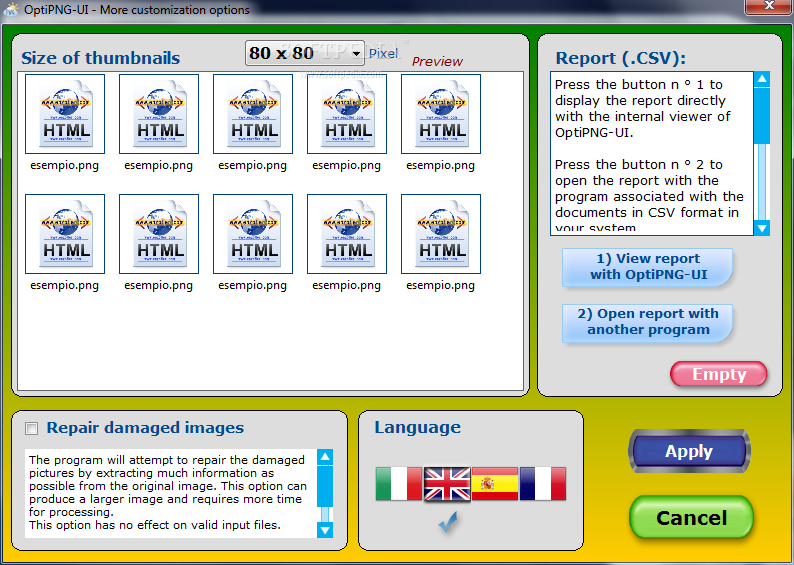

Squash is essentially a drag and drop no brainer utility, drag images in and Squash does the best. You can't really go wrong using either utility. It's surprising too, as ImageOptim offers more options for optimization and the same optimization libraries. Squash isn't as accomplished in JPEG optimization as ImageOptim but seems to be best PNG GUI utility for OS X. Squash 2 is part of SetApp collection or $15 stand alone. That said, ImageOptim is quite good for the sticker price of free. While hardly the epitome of comprehensive testing, Squash does provide slightly better PNG compression. This last test weighs in the most for the favor of Squash, 330,665 bytes is significant, even if only a 6% difference The Results. Kaleidoscope Show differences results: No Differences I checking PNGCrush, brought it down 1,126,420 bytes. On very large PNGs, Squash 2 has the advantage. I'm a little surprised that Squash shaved off a few more K. Neither of these is terribly surprising, Squash uses LibPNG and Zopfil, which are open source PNG optimizations. Kaleidoscope Show differences results: No differences Squash Savings over ImageOptim: 21,939 bytes (21.9K), 1.3% Kaleidoscope Show differences results: >No differences
Imageoptim vs. optipng full#
If you're using Guetzli, I'd argue it's easier to provide alternative image formats (WebP / JPEG 2000) as opposed to burning hours encoding a hand full of images as you'll get better results for the people who can see them (Safari and Chrome users). We're probably quickly approaching the end of the law of diminishing returns. These all can take minutes to execute on larger images, and the longest being Guetzli, a 8 MP image can take around 40 minutes to encode even a 5th generation Core i7. These libraries do not come without a penalty, that being CPU cycles. Both ImageOptim and Squash are GUI front ends that make use of these optimizations to create the best JPEG or PNG per kilobyte possible. These all differ as some are encoders, and some are strictly optimizers but the end game is to extract the most out the formats which often involves trickery to exploit the compression. PNG has Zopfil, PNGOUT, OptiPNG, AdvPNG, PNGCrush. Interestingly though, there's a been a concerted effort to squeeze every bit of optimization out of the existing formats: JPEG has MOZJpeg, Guetzli, JPEGOptim, and Jpegtran. It may take some similar act of corporate benevolence to bring a successor to JPEG.
Imageoptim vs. optipng for free#
It took Cisco buying and distributing the Mp4 patent for free to move MP4 to the accepted video formation for Microsoft, Apple, Google, and Mozilla. We're starting to see future image formats like Google with WebP, and Apple with JPEG2000 and HEIC, and Safari allowing inline MP4s to be treated as images but for the past 10 years, much of the action in image compression has been trying to squeeze out ever last single byte out of the existing formats, almost entirely for JPEG and PNG (and SVG but that's a different story) A lot of the slow movement of web formats has to do with the W3c.
Imageoptim vs. optipng software#
These are intermediate formats that require specialized software to view/edit and converted when distributed beyond professional means (sans EPS). You may occasionally PSDs or EPS files, or photography formats like DNG or standard-free RAW, but those fall into the same category as video codecs like ProRez, DNxHD, Cineform. However, static images haven't had the wide range of codecs (most formats are lossless proprietary files used by various image editors) and have been almost entirely relegated to five formats, SVG, BMP, PNG, JPEG and GIF for distribution. Audio has had a similar vector from LMA4:1, Mpeg, MP2, Mp3, ACC, Ogg, AC3, DTS to name a few.

This doesn't even cover the other formats, VP8, VP9, Ogg Vorbis, DIVX, 3IVX, Sorenson, Real Media and the many others that occurred the past 30 years which all have had variations of mainstream success. Each iteration with the ultimate goal of improving video quality with at lower bit rates.

Over the years, codecs have improved remarkably, especially in the realm of video: For example: H.261 (1984, 1988) -> MPEG-1 (1988-1991) -> MPEG2 aka H.263 (1996-2015) ->MPEG4 aka H.264 (1999-current) -> High Efficiency Video Coding (HEVC) aka H.265 or MPEG (2015 - current). I recently decided to finally try out Squash by Realmac Software. I tend to be a little obsessive, using modern formats (WebP, JPEG 2000) and testing out avant-garde projects like Guetzli by Google.

For years I've leaned on ImageOptim as my go-to for image optimization.


 0 kommentar(er)
0 kommentar(er)
